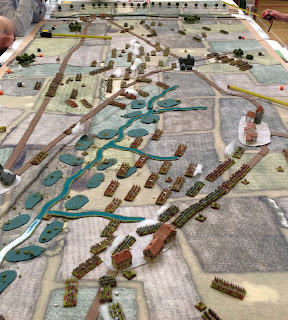This month, in 217BC, Hannibal pulled off one of his greatest victories over the Romans at Lake Trasimene in the modern day Umbria region of Italy. A family holiday this week brought me within range of the battlefield.
Hannibal is the ancient general I most admire. Others may have been more victorious, but few had his leadership challenges, commanding a largely mercenary army in a campaign that took his army over the Alps and onto Rome's own territory. It was also my very first wargame army.
The previous year 218BC, Hannibal had consolidated his position amongst the Gauls and defeated a Roman army on the Trebbia. He wintered north of the Appenines and chose a particularly difficult pass south, which meant the two Roman armies waiting for him could not combine. The route took him through the marshy Arnus river basin, where he lost an eye to infection and made the journey on the remaining elephant.
He passed close to the camp of the Roman Consul Caius Flaminius at Arretium (Arrezo), ravaging Roman property to provoke him. However, Flaminius resisted the temptation and followed Hannibal down to Lake Trasimene, hoping to catch him between his and the other Roman army.
A view of the hills surrounding the northern end of the lake.
Hannibal spotted the opportunity the ground north of the lake offered him. He positioned his veteran foot on a hill, the site of the modern village of Turo, tempting Flaminius to attack. As the Roman army began to deploy from march columns, Hannibal signalled the flank attacks using Gaulish foot and the combined Punic cavalry. His light horse sealed the trap.
Some 15,000 Roman troops were killed (including Flaminius) and probably another 15,000 were taken prisoner. Hannibal released Rome's allied troops as part of his strategy to encourage them to break away from Rome. Hannibal lost around 1500 men, mostly Gauls.
There is some contention over the exact site of the battlefield, but the modern consensus favours the Sanguineto basin as the killing ground. There are 12 information boards at various stages of what is called the Hannibalic Path. They are very well done, with descriptions of the troops and key stages of the battle. The signposting could be better, but you can walk or drive around the route.
One of the twelve information boards
This picture is taken from what is thought to be Hannibal's command post, from where he signalled the attack. Yes, my 'world tour' Hannibal T-Shirt got some proper use!
No statue of Hannibal, but there is one of Flaminius. He comes in for a lot of criticism, but it's hard to see what else he could have done but attack. His failings and that of most Roman commanders of the period was poor reconnaissance.
This is an excellent battlefield to visit, as it's fairly easy to visualise and the local authorities have done a good job of presenting it to the visitor. Just south of the battlefield, is the lovely medieval town of Castiglione del Lago. A good place for some lunch and a fine medieval castle to visit as well.











































